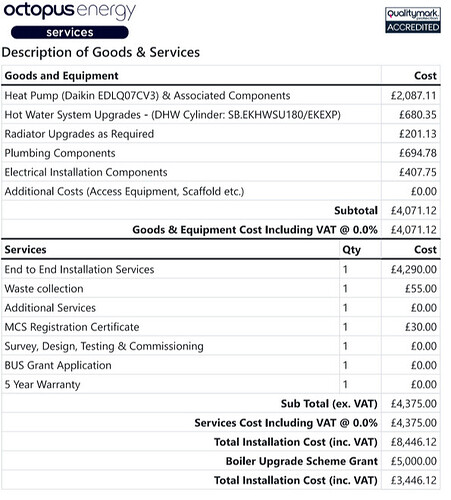Hi, Belgian experience here,
5 years ago we bought a 10-year-old 270 sqm house with a vaillant propane boiler with underground tank, underfloor heating and radiators upstairs. I didn’t know anything about underfloor heating or gas boilers, so I looked into how they worked, first by changing the thermostat so that it would finally modulate with an outdoor sensor, then by trying to balance the radiator circuit and the underfloor circulator … mission impossible, the boiler was too powerful, 8 > 25 kW, starts and stops constantly, causing thermal discomfort, from there start the idea of a heat pump…
we consume about 1200L of propane, i.e. 14.000 kWh, about 1000€/year we also make a small fire in the evening, 5 steres of wood per year.
We also have 12.7 kWp of photovoltaic panels on the roof ( 10 K Solaredge full South and 38 LG panels) , which have now paid for themselves, producing between 14 & 16,000 kWh on average. And 2 Tesla cars covering 70,000 km/year. DHW is done by a 300 L Thermodynamic boiler at 50°C.
I thought I’d need a 12 kW heat pump, then last year I came across the heatgeek channel, then Urban Plumbers’, and after calculations I came up with the need for an Arotherm+ 7kW. On a sales site, I found an unpacked, never-installed 5 kW for 2,700€, so I decided to try it out, keeping the gas boiler as a parallel hybrid installation if I’ve made a mistake in my calculations or the 55 isn’t powerful enough. It would kick in when COP is lower than 2.25, I hope never.
I redid all the primary circuit hydraulics in 28mm and replaced the floor distributor to balance everything properly.
The total cost was 4,500€.
. 2700€ for the Arotherm+ 55 heat pump
. 400€ for the Vaillant electronic control module
. 1400€ for the pipework and valves, etc…
Untill 2030, luckily in our region, I can count on my electricity meter “running backwards”, which means that the grid acts as a battery, for around 850€ of “tax” per year. I now have untill 2030 to think about a huge battery setup. The annual solar production, which doesn’t cover our total consumption, will make the kWh cost me between 0.10 and 0.15€/kWh.
I’m thinking of achieving a SCOP of 4 ( I’m over 5 for now on this November ) , i.e. a requirement of 3,500 kWh = €450/year, so we’d need about 8 years to pay off this installation. it’s not a bad price to pay to free ourselves from fossil resources. not to mention that since it’s been running, we’ve finally got comfort, which we didn’t have with the gas boiler.
We are only at the beginning of our first winter with this installation, so to be continued…



